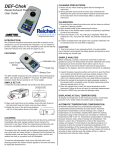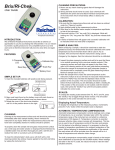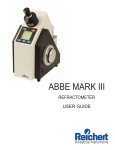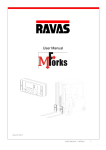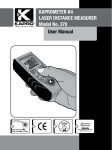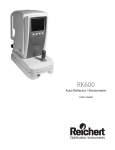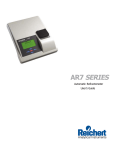Download Vet360-Chek - Reichert Technologies: Analytical Instruments
Transcript
Vet360-Chek To clean the refractometer’s body use a soft cloth with a mild cleaning solution like window cleaner applied to the cloth and follow by wiping the instrument dry. Veterinarian-TS Meter User Guide CLEANING PRECAUTIONS: 1. Never use any harsh cleaning agents that will damage the instrument. 2. Strong solvents should never be used. Such chemicals will deteriorate the prism seal and attack individual component material which will adversely affect or destroy the instrument. CALIBRATION: INTRODUCTION: We at Reichert Analytical Instruments would like to extend our appreciation to you for purchasing this instrument. It is our mission to provide a quality product at a very competitive price and we feel this instrument will prove its value time and again to you. Sample Well FEATURES: 1. Be sure that the measuring surface and well are clean as outlined under the “Cleaning” section. 2. Apply distilled water to the measurement surface. 3. Allow time for the distilled water sample to temperature equilibrate to that of the instrument. 4. Press and hold the “CAL” key until CAL is displayed. While still holding the “CAL” key press the “READ” key and then release both keys. 5. A series of dashed lines will appear and successful calibration will be indicated when the word END is displayed. SAMPLE ANALYSIS: Liquid Crystal Display Read Key Calibration Key Scale Key Battery Door The Vet360-Chek has been designed for simple analysis of specific body fluids in veterinarian medicine. Four scales provide measurement of serum protein levels and urine specific gravity for canines, felines and large animals. SIMPLE SET UP: 1. Insert the included batteries with positive side facing outward. Before analyzing a sample, it should be noted that to attain the greatest accuracy the refractometer should be calibrated at the same temperature as the environment that it will be used in. As an example; if the environment that the instrument is being used in changes by five degrees, then the instrument should be re-calibrated. 1. Inspect the glass measuring surface and well to be sure that there is no residue remaining from a previous sample analysis. If the measuring surface and well does not appear to be clean, then refer to the cleaning section of this user guide before proceeding. 2. Extract the sample to be tested and apply adequate sample to the sample well to completely cover the glass measuring surface. Minimum sample size is 0.3 mL. 3. Allow the sample time to reach the same temperature as the instrument. Failure to do so will result in inaccurate measurement. 4. Press the “READ” key and note the displayed value and the position of the annuciator. The annunciator should be located below the fluid scale that you are attempting to attain a reading for. If the position of the annunciator is not located under the desired scale, then press the “SCALE” key until the annuciator position indicates the correct scale. SCALES: 2. Align small mark found on the battery cover with mark found on the instrument body and insert cover as shown above. 3. Rotate the cover in the clock wise direction until it is in the position shown to the right. CLEANING: Cleaning of the measurement surface and well should be performed immediately after each sample reading. Never immerse the instrument in any liquid. When the measurement surface and well have been completely cleaned no residue should be present. To properly clean the sample well and glass measurement surface use a mild soap and water solution or Isopropyl Alcohol followed by a distilled water rinse and then thoroughly dry with a soft lint and residue free cloth or a product such as Kimwipes®. To change the reading mode scale between Canine USG, Feline USG, Large animal USG and Serum protein, press the “SCALE” key to toggle through those choices. The annuciator displayed on the screen denotes the active scale. Displaying Actual Temperature: To display the temperature at the measuring surface, momentarily press the “CAL” button while the sample value is displayed. AUTOMATIC TEMPERATURE COMPENSATION: All Reichert refractometers are automatically temperature compensated assuring extremely accurate results. Automatic temperature compensation corrects readings over a range of temperatures. As an example; samples taken within the working temperature range of the instrument are corrected to a reference temperature of 68° F (20° C). Temperature compensation is essential because refractive index varies inversely with temperature. This feature is used in lieu of temperature control of the measuring surface and sample. For this feature to be effective however, it is necessary to allow the sample to temperature equilibrate to the ambient temperature of the measuring surface. Without allowing for temperature equilibration of the sample the read values will not be as accurate as they could be since the sample will be in a state of temperature and refractive index change. ERROR CODES: Err01 - No sample present. Add sample. Err02 - Inadequate sample. Add additional sample. Err03 - Sample exceeds the refractive index reading range. Err04 - Sample temperature has not equilibrated. Allow more time for temperature equilibration. Err05 - Excessive ambient light. Cover sample well when reading. Err06 - Excessive ambient light. Cover sample well when reading. Err07 - Positive calibration error. Re-calibrate with distilled water. Err08 - Negative calibration error. Re-calibrate with distilled water. Err09 - Poor sample condition. Sample may not be able to be read. Err10 - Sample type may not be able to be read. Err12 - Index of sample is out of range of instrument. Err5X - For any errors in this series contact Reichert Analytical Instruments for technical assistance. BATTERY CONDITION: The following display examples represent either a low battery condition or an extremely low battery condition where the instrument will no longer operate properly. In either case the batteries should be promptly replaced. Battery condition low. Replace Batteries. SPECIFICATIONS: Catalog 13940018 Reading Scales Canine urine specific gravity Feline urine specific gravity Large animal urine specific gravity Serum Protein, g/100mL Reading Ranges, Canine USG, 1.000 to 1.060, Accuracy +/- 0.005 Feline USG, 1.000 to 1.090, Accuracy +/- 0.005 Large Animal USG, 1.000 - 1.061, Accuracy +/- 0.005 Serum Protein, 2.5 - 15.0, Accuracy +/- 0.1 Calibration - Distilled Water Automatic Temperature Compensation - 68°F (20oC) The built in temperature compensation mode is based on the temperature coefficients that have been calculated for the individual solutions offered in this instrument. Prism - Glass Illumination - 589nm LED Dimensions - 54 x 27 x 100 mm / 2.13 x 1.06 x 3.9 inches Power - 2 AAA Batteries, included. Battery life - 10,000 readings, Auto Off Sleep Mode. Ratings - IP65 Dustproof/Water Resistant, CE, RoHS, and WEEE compliant. Warranty - One year against manufacturing defects. Evidence of tampering voids warranty. Battery condition extremely low. Replace Batteries. Reichert Technologies Analytical Instruments 3362 Walden Ave Depew, NY 14043 USA Toll Free: 888-849-8955 Phone: 716-686-4500 email: [email protected] www.reichertai.com Reichert GmbH Hubertusstrasse 2 D-82229 Seefeld Germany Tel: +49-8152-99-3530 ISO-9001 Certified 13940018-101 REV 1A


